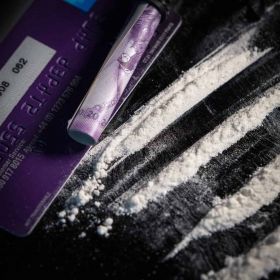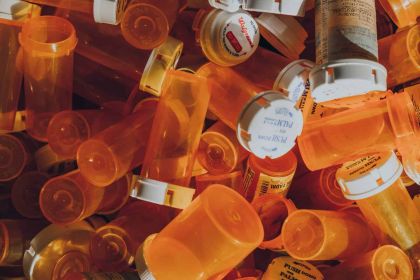Opioid Addiction
Opiate Addiction Treatment
Opioid drugs are those that interact with the body’s opioid sensors in the central nervous system. Learn more about our opiate rehab center in Los Angeles, as well as what makes opioids so dangerous.
These drugs are able to reduce pain and depress the nervous system. This can often lead to opiate addiction.
Some common kinds of opioids include:
-
Morphine
-
Codeine
-
Opium
-
Heroin
-
Hydromorphone
-
Hydrocodone
-
Oxycodone
-
Fentanyl
Opioid drugs may be synthetic, natural opioids, or semi-synthetic. Our opiate rehab center in Los Angeles can give you the tools necessary for lasting recovery.

What Happens When Opioids Are Misused?
When opioids are abused, there are several side effects that could occur. Some of the short-term side effects of opioid abuse include:
-
Drowsiness
-
Nausea
-
Euphoria
-
Slowed breathing
-
Confusion
-
Constipation
In some cases, the slowed breathing that results from opioid misuse may lead to hypoxia. This is a condition in which the brain doesnt get enough oxygen. As a result, the misuse of opioids can have significant short- and long-term neurological and psychological effects. Signs of acute opioid abuse or an overdose may include:
-
Comas
-
Permanent brain damage
-
Death
It is necessary for people to understand that overdoses are possible when taking opioids. Prescription opioid overdoses are life-threatening and have resulted in peoples deaths in the past. Usually, people stop breathing when they overdose, because the central nervous system is too depressed to function normally.
Fortunately, Naloxone can be used to reverse the symptoms of an opioid overdose if it is administered quickly.
Call Us 24/7: (855) 652-9048
We are an in-network provider with Anthem, First Health Network, Multi-Plan, Beacon, HMC, Humana, Aetna
Why Would Anyone Misuse Opioids?
The reason that some people misuse opioids is that they relieve pain and can give a feeling of intense relaxation or euphoria. Euphoria, specifically, is common among those who misuse the drug.
Opioids are known to release dopamine, which is a feel good chemical in the body. As a result, the act of abusing opioids is reinforced, and an addiction may form.
-
Extreme energy
-
A false sense of well-being
-
Insomnia and hyperactivity
-
Hallucinations and delusions of power
-
Anxiety, aggressiveness, and irritability
-
Paranoia
-
Lack of appetite and nausea
-
Hyperactivity
How Are Opioids Misused?
According to the National Institute on Drug Abuse, opioids are commonly misused by:
-
Taking the medication in a larger dose or way in which it was not prescribed
-
Taking the medication specifically for its effects, such as feeling euphoric
-
Taking another persons medications without a prescription
Misusing opioids is unfortunately common, and the drugs may be swallowed, injected, dissolved in water, or even snorted.
Opioids are known to have a high potential for abuse. Repeatedly misusing a prescription opioid or illicit opioid drug may result in a substance use disorder. An SUD happens when the drugs continued use leads to health problems, changes in the brain, and a failure in the ability to maintain normal daily activities
Additional Resources
How Is An Opioid Use Disorder Treated?
Opioid Use Disorder, the medical term for addiction to opioids, is treated in 1 of a few possible ways. According to American Family Physician, OUD can be treated with pharmacotherapy, which may also be called medication-assisted treatment, behavior therapy (like cognitive-behavioral therapy), and Naloxone, which reverses the effects of an opioid overdose. These 3 options combined give patients a well-rounded treatment plan.
Physicians agree that OUD needs to be treated as a chronic condition. There are genetic, behavioral, and environmental causes of the condition, and the disorder responds best to long-term treatment and medication supplementation.
Yes. The first step of treatment is to enter into a detoxification program. This is because stopping opioids suddenly could result in withdrawal. Withdrawal can be painful, uncomfortable or dangerous. In some cases, it may be life-threatening. Our opiate rehab center in Los Angeles can help you recover safely and effectively.
-
Absolutely the best recovery center around.
I am forever grateful to have had this experience. I would recommend anyone who wanted help to come here. This place literally saved my life. I have overcome so many obstacles that always stood in the way of my recovery. It’s not just because I was ready… the approaches the therapists use come from an empathetic, compassionate, and understanding place. They were able to hold the mirror up and help guide me through making solid changes.
Daniel H.
August 2017 -
This place literally saved my life.
After overdosing, my parents forced me to check into rehab.After interviewing many other facilities, I decided to go to Harmony Place from my home in Phoenix. I was struggling with…a drug addiction and had been trying for years to recover. In the past, left 2 treatment centers AMA and 1 AWOL. I had very negative experiences in the other treatment facilities, especially with my therapists, so I didn’t go in with an open mind or good attitude- even though they worked with my parents regarding finances. However, the staff was patient with me. The techs were kind, knowledgeable, and many were in recovery themselves.
Mary M. -
They Answered on the First Call
When I called Harmony Place…I knew immediately that this was the right place for my child… Harmony Place is specifically designed for…and tailored to providing a safe environment. The staff [are knowledgeable and some are in recovery]. The staff knew each client and were on top of each client’s progress. Harmony Place has a small clientele and each client are able to receive all the help they were entitled to. I would recommend Harmony Place to anyone who is looking for a small setting… My daughter is currently going into sober living and her counselors did a wonderful job in finding a right fit for her – affordable, safe and a good environment for her.
Robyn
Loved-One -
I’ve Been Searching for the Perfect Words…
I left Harmony Place in August of 2015 and I have been searching for the perfect words to describe my experience during my stay; and still I can’t really find them. How do you really describe a place with a staff and a program that saved you? Addiction is a terrible thing to go through and a heart breaking thing for your loved ones to watch. Many people, including myself go into different treatment centers throughout their addiction searching for ways to find recovery. Nothing worked for me, not the 5 rehab stays I had, then, I came here.
Dominique C.
Alumni
What Are the Signs of Withdrawal from Opioids?
When someone is withdrawing from opioids, they may have symptoms such as:
-
Trouble sleeping
-
Diarrhea and vomiting
-
Severe cravings for their opioid medications
-
Cold flashes
-
Bone and muscle pain
The symptoms may be severe and extremely uncomfortable, which is why most people aren’t able to stop using opioids on their own. Fortunately, there are detoxification programs that can help with medication-assisted treatment and other options.
Opioid withdrawal may start as soon as 8 to 12 hours after the last dose of heroin, for example, or within 36 hours of the last dose of methadone. Each type of opioid is a little different, so when the symptoms begin will depend on:
-
How often the drug was taken
-
If it’s a short- or long-acting drug
-
What the dose was
It’s a good idea to enter into a medical detoxification program, because serious complications4 can occur during withdrawal, like severe gastrointestinal issues leading to dehydration or autonomic arousal, which increases your blood pressure, pulse and other stats.
Don’t Wait Any Longer. Reach Out & Begin Your Journey of Healing Today.
Medication-Assisted Therapy
Medication-assisted therapy, which is also known as MAT, is a therapy where certain medications are used to replace a more dangerous drug or to minimize the symptoms of withdrawal. They also help manage the risk of relapsing.
Two of the most commonly used drugs in MAT include buprenorphine and methadone. Sometimes, Naloxone is also used in these programs. Some more information about the medications is listed below.
Buprenorphine5 is one of three drugs approved for the treatment of opioid dependence.6 Buprenorphine is an opioid partial agonist. What that means is that the drug does not produce euphoria or respiratory depression at the same level as a full opioid. While it can produce those symptoms, its much less likely.
Buprenorphine is safe when its used as directed. It has special effects that make it suitable for treating opioid disorders, such as:
- Increasing safety in the case of an overdose
- Lowering the likelihood of misuse because of a lack of feel good effects
- Diminishing the effects of withdrawal
Methadone7 is a full opioid agonist and controlled substance used to treat opioid addiction and dependency. Like morphine, it is an opioid used to treat pain. Methadone can be habit-forming, but it is largely safer than taking other kinds of opioids, such as heroin or fentanyl. It is a long-acting drug compared to other opioids, which makes it helpful for inpatient and outpatient detox.
Yes, because MAT has been shown to decrease opioid use, increase social functioning, and retain patients in treatment programs. New drugs, and improved medications, are being worked on all the time for opioid addiction treatment. For example, in 2017, Sublocade9 was approved for once-a-month injection into those with an opioid use disorder. This kind of long-term dosing has been shown to eliminate the need for daily doses of opioids and to improve the outcomes of patients in treatment programs.
Despite the fact that MAT is known to have excellent outcomes, fewer than half of all privately-funded treatment programs offer it. Only around a third of people with opioid dependencies end up receiving MAT treatment.10
Yes, because MAT has been shown to decrease opioid use, increase social functioning, and retain patients in treatment programs. New drugs, and improved medications, are being worked on all the time for opioid addiction treatment. For example, in 2017, Sublocade was approved for once-a-month injection into those with an opioid use disorder. This kind of long-term dosing has been shown to eliminate the need for daily doses of opioids and to improve the outcomes of patients in treatment programs.
Despite the fact that MAT is known to have excellent outcomes, fewer than half of all privately-funded treatment programs offer it. Only around a third of people with opioid dependencies end up receiving MAT treatment.
What Are Other Treatment Methods Available for Opioid Addiction?
Once patients are in an addiction treatment program, there will be a variety of options available. To start with, patients will select from an inpatient or outpatient program.
Inpatient programs are created to give patients a place to have 24-hour, around-the-clock medical care. They live at the facility and may or may not have contact with the outside world, depending on the program. Generally speaking, these programs are between 30 and 90 days long, though there are some longer 180-day programs and other forms available.
The Freedom from Heroin Addiction Treatment in Los Angeles at Harmony Place
The best treatment for an opioid use disorder will depend on a person’s specific needs. Someone who is dependent, but not having psychological cravings, may do well with a tapering program or detox and private therapy. Someone with strong cravings and an uncertain home environment may enjoy an inpatient program where they’re monitored and taught new coping strategies.
At our heroin and opiate rehab center in Los Angeles, we offer MAT as well as other treatment options that may help you or someone you love to get sober and stay that way. We believe that everyone deserves an opportunity to get the help they need and are standing by to help you get into the right treatment program today. Chat with us online or call us today at 1 (855) 652-9048. Whether it’s yourself or a friend or relative who needs support, we’re ready to support you on this journey.
- National Institute on Drug Abuse. Opioids
- National Institute on Drug Abuse. DrugFacts- Prescription Opioids
- American Family Physician. Opioid Use Disorder: Medical Treatment Options
- U.S. Department of Health and Human Services. Detoxification and Substance Abuse Treatment
- MedlinePlus. Buprenorphine Sublingual and Buccal (opioid dependence)
- U.S. Food and Drug Administration. Information about Medication-Assisted Treatment (MAT)
- MedlinePlus. Methadone
- National Institute on Drug Abuse. Opioid Overdose Reversal with Naloxone
- U.S. Food and Drug Administration. FDA approves first one-monthly buprenorphine injection, a medication-assisted treatment option for opioid use disorder
- HK Kindsen et. Al. Journal of Addiction Medicine (2011).


























